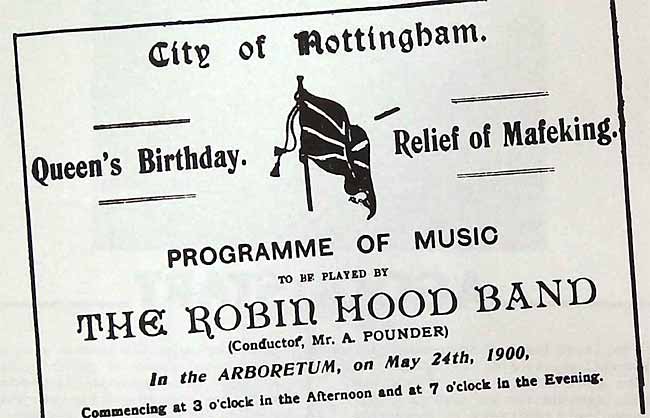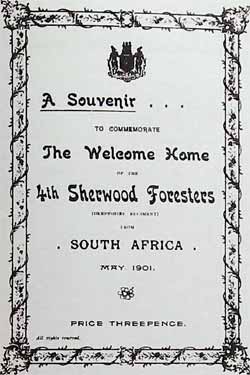< Previous
Imperial Echoes
Steven Best our local history correspondent writes about Street Names in Sneinton

Street names in Sneinton, as in most places, reflect the local and national preoccupations and personalities of the times, as well as the whimsy of the private builder. In this issue we look at some turn-of-the-century streets which recall the high noon of Empire.
Off Windmill Lane are the twins LORD STREET and ROBERTS STREET, commemorating 'Bobs’, Field Marshal Earl Roberts. His was one of the most illustrious of military careers, beginning, as so many did, in India.
As a young officer Roberts was awarded the Victoria Cross for extreme bravery in 1858 during the Indian Mutiny. He later saw action in Abyssinia and Afghanistan, culminating in 1879 in his famous march to lift the siege of Kandahar. To reach Kandahar his column of 10,000 men covered 313 miles in 22 days. With the outbreak of the Boer War Lord Roberts was again to the fore. In 1899 the British Army suffered three disastrous defeats: in one of these, Colenso, Lord Roberts's son, also a V.C. winner, was killed.
At the age of 67 Roberts was sent out to South Africa as supreme commander of the field force and after a successful campaign he returned to England to an Earldom, and to be Commander-in-Chief of the Army. He died in 1914 in his eighties while visiting Indian troops in France.
Lord Roberts, with two streets named after him, fares better in Sneinton than does Lord Nelson, who has to be content with one.
A fine clutch of street names off Colwick Road has a strong link with Lord Roberts, recalling more people and places from the Boer War.

First come the three streets commemorating sieges: KIMBERLEY STREET, LADYSMITH STREET and MAFEKING STREET. An important town in Cape Province, Kimberley was a centre of the diamond mining industry. From October 1899 until February 15th, 1900, its defenders held out against near starvation and Boer shelling until relieved by forces led by Sir John French. Two weeks later the siege of Ladysmith in Natal was over. The occupants of Ladysmith fared the worst of all those in the South African sieges: 22,000 people, desperately short of food, fighting off the Boers until, at last gasp, they were relieved by Sir Redvers Buller's troops. Mafeking in Cape Province became the most celebrated of the siege towns. From October 12th, 1899 to May 17th, 1900, it was held by Col. Robert Baden-Powell until a flying column relieved it. The scenes of rejoicing in the streets of London which greeted the news of the Relief of Mafeking beggared description, and brought a new word to the English language. The crowd behaviour was called 'mafficking', and from that day 'to maffick' has meant to celebrate with hysterical boisterousness. The defender of Mafeking's memorial in Sneinton is of course BADEN-POWELL ROAD. After the siege he was promoted and organised the South Africa constabulary before founding the Boy Scout movement in 1908. Despite his popularity with the public, Baden- Powell did not escape rumours which suggested that he had not done all he might to shorten the siege. He retired from the Army at 53, and when he offered his services in the Great War, was given only a very humdrum job.
Another personality of 1900 is remembered by KINGSLEY ROAD. Born in 1862, Mary Kingsley was an English traveller and author who studied native religion and law in Africa, exploring much unknown country in the Congo. Her great concern was for the future of the African, and she hoped for an administration of the British possessions there which left the native 'a free unsmashed man, not a whitewashed slave or an enemy.' While preparing for a third journey to West Africa she heard of the outbreak of the Boer War, and went instead to South Africa to tend fever cases. She died of enteric fever on June 3rd, 1900 while nursing Boer prisoners.
Nearby, PORT ARTHUR ROAD recalls a place which, almost forgotten today, held the world's attention in 1904. Never an outpost of the British Empire, it was nonetheless named by a British admiral in 1860. Port Arthur (or Ryojun) was a town of great strategic importance in Manchuria, in the north east of China. It was the chief Chinese naval arsenal until 1894 but after the Chino-Japanese War it was taken by Japan, which was forced to retrocede it to China. In 1897, Russia, needing an ice-free port for her Pacific Fleet, occupied Port Arthur, and in 1898 secured a 25 year lease on the peninsula on which it stood. Port Arthur became a fortress, and as Russia's main strength in the east, saw some terrible fighting during the Russo-Japanese War. The port was besieged from July 1904 to January 1905, and the Japanese took it at a cost of 40,000 dead. Port Arthur was transferred to Japan in 1905, but is now part of the People's Republic of China.
The Boer War and the Russo-Japanese War passed into history, but builders ensured that the people and the sieges were remembered in Sneinton and a hundred places like it. The first residents moved into Lord Street and Roberts Street in 1902, and into Kingsley Road in 1903. The following year, 1904, saw Ladysmith Street and Baden-Powell Road appear as local addresses, to be joined in 1906 by Mafeking Street. The last two of these commemorative streets, Port Arthur Road and Kimberley Street, were first lived in during 1907.
STEPHEN BEST
Illustrations by kind permission of Local Studies Library, Nottinghamshire County Library.
< Previous
